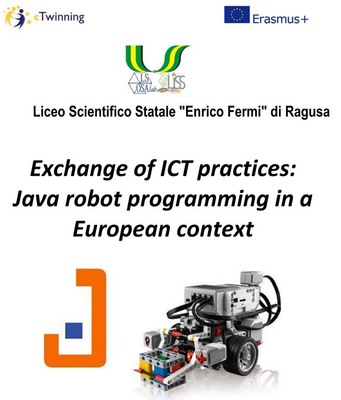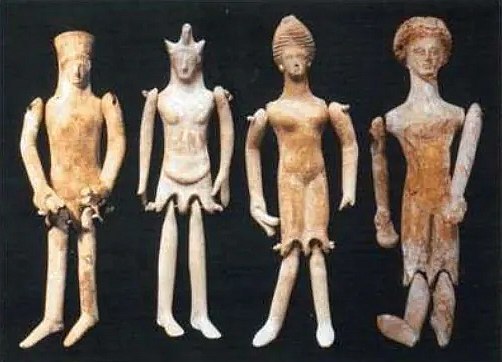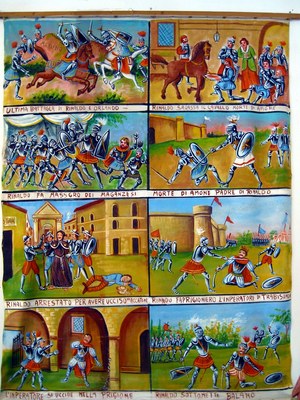
The "Opera dei Pupi" is one of the most important symbols of Sicily, it was born as a form of entertainment for the Sicilian public and, nowadays, it has become a Unesco heritage. It is a type of theatre with very ancient origins, which has evolved over the time, manifesting itself in different forms depending on the city it belongs to.
The Sicilian puppet, called “pupo”, has a really old tradition. Its history is traced back to 2400 years ago with the Symposium of Xenophon (Xenophon IV, 52-55) (444-354 B.C.). It was called “Neurospasta”, a Greek word that meant puppet.

Over the course of the centuries, further traces of puppets were found, but the official birth of the theatre of the Sicilian puppets was documented in the nineteenth century.
During the Romantic Age, the great poems of the chivalric literature were rediscovered: plots woven of love, betrayal, spells and duels. The history of the Paladins of France became the “bible” of puppeteers.

The puppets began to be dressed with shining armor and in between, the “cuntisti”, professional storytellers of the Carolingian cycle, appeared. The stories of Orlando were handed down by oral tradition from master to apprentice. The deeds of the Paladins were narrated by storytellers following a canvas with images and explanatory texts.

When you come to Sicily, you cannot miss a performance at a Puppet Theatre in Palermo, Catania or Syracuse. Every “Opera dei Pupi” will transport you back to the world of Orlando and Rinaldo, two of the heroes of the famous History of the Paladins of France, a set of medieval stories focused on the court of Charlemagne and his knights.
In Palermo you can also visit the International Puppet Museum which hosts the largest collection of Sicilian puppets.
<---o--->
For our final Erasmus+ project we thought of creating our Sicilian Puppet Theatre but, instead of using the classic puppets, we decided to use our robots built by simulating the human appearance of paladins, equipped with helmets, armor, cloaks and swords and programmed to move, to fight, to win and to die.
In addition, we needed to build a small theatre and write a script for a story involving the classic characters: King Charlemagne, Orlando, Angelica, Rinaldo, Gano di Magonza the traitor (the Paladins of France) and Guarniere, Marsilio, Pulicante, Agolante, Almonte (The Saracens).
Here is the design of our theatre:

already printed in 3 parts by plotter on 3 sheets in A1 format (total size 178x84 cm)
and also the background with the walls and the skyline of an ancient medieval town:

As for the Paladins, we thought of creating a bipedal robot that walked like a person. It wasn't easy! The first attempts failed miserably. In fact, when the robot lifted a foot to take a step, it inexorably fell on that side.

By analyzing the situation we understood how the advancement of a bipedal animal like man is difficult and delicate. After considering some knowledge of Physics we realized that the center of gravity had to fall within the support surface and this does not happen when the robot lifts one foot!
To solve the problem of the robot falling down, we have adopted 2 tricks:
- increasing the surface of the robot's "feet" ;
- tilting the robot to the opposite side of the raising foot so that the center of gravity falls into its support base, now enlarged thanks to point 1).
The Paladin robot also needed to be remote controlled to operate the forward and backward movements; to achieve this, we have equipped the robot with an infrared sensor which is controlled by its remote control:

Nevertheless, the movements of our robot still presented some problems that we have almost completely fixed.
- If the robot tilts quickly it falls on that side. Solution: we have widened the "feet" outwards.
- The robot's feet slide on a smooth surface. Solution: to increase the "grip" under the feet we have placed the red rubber pads included in the extension kit.
- The robot must be remotely controlled from behind. Solution: we have moved the infrared sensor to the rear.
- The robot cannot turn. Solution: we have placed a small wheel driven by a small motor behind it to make it spin.
- The robot must have an anthropomorphic appearance. Solution: we have placed the distance sensor at the front to simulate the eyes.
- The robot is a warrior, it must operate with sword and shield. Solution: we have added two "arms" on the sides, each moved by a small motor; on the right we created the arm that wields the sword, and on the left we put the arm that holds the shield and fends off the opponent's blows.
Here's how the final robot looks like:




Download LDD file: Paladino2
Download EV3 code as a prototype, not yet in Java code : https://bit.ly/3yYBl42
To remake our projects and to open .lxf files above you need the program Lego Digital Design, download it for Windows.
Finally, you have to dress the warrior with the cloak, a bodice, a shield and give him a face. Here is the near-final prototype:

The occurrence of the COVID-19 pandemic and its persistence until the end of the project prevented the continuation and conclusion of this interesting activity, certainly intriguing for students and teachers from other countries but also useful for Sicilian students to rediscover the roots of their own cultural traditions.
<---o--->
On our school website we have published a video which illustrates the main additional activities that we carry out, including the Erasmus+ project.

The video shows the teacher responsible for Erasmus+ and a student who participated in it; the girl describes (in Italian) the objectives and didactic peculiarities of robotics.
TRANSLATION: Robotics at "Liceo Fermi" helps to develop computational thinking and problem solving because it helps you to reason and solve problems. It develops dynamics of group-work and peer learning even among pupils of different classes, promoting processes of inclusion. When we talk about Robotics we are talking about involvement, curiosity, laboratory school where you learn by playing. The desire to learn is reached when motivation and curiosity come into play. Think about it!
Sicilian souvenir